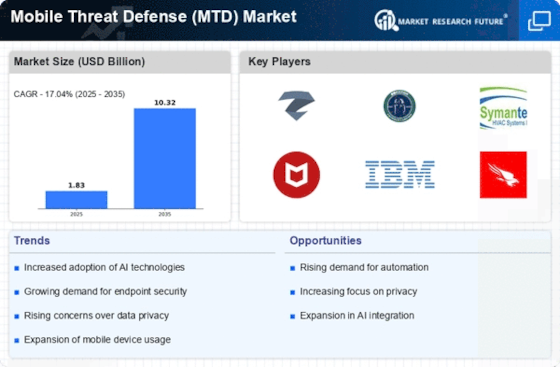Escalating Mobile Cyber Threats
The Mobile Threat Defense Market (MTD) Market is witnessing a surge in demand due to the increasing frequency and sophistication of mobile cyber threats. As organizations increasingly rely on mobile devices for business operations, the attack surface expands, making them prime targets for cybercriminals. Reports indicate that mobile malware attacks have risen significantly, with a notable increase in phishing attempts and ransomware targeting mobile platforms. This escalation in threats compels businesses to invest in robust MTD solutions to safeguard sensitive data and maintain operational integrity. The urgency to protect against these evolving threats drives the growth of the MTD market, as organizations seek to implement comprehensive security measures that can adapt to the dynamic threat landscape.
Rise of Remote Work and BYOD Policies
The rise of remote work and Bring Your Own Device (BYOD) policies is a significant factor propelling the Mobile Threat Defense Market (MTD) Market. As more employees work from home or on the go, the reliance on personal devices for accessing corporate resources has intensified. This shift creates a myriad of security challenges, as personal devices may lack the necessary security measures to protect sensitive data. Consequently, organizations are increasingly adopting MTD solutions to mitigate risks associated with remote access and BYOD practices. The need for comprehensive security strategies that encompass mobile devices is becoming more apparent, thereby driving the growth of the MTD market as businesses seek to secure their mobile environments.
Advancements in Mobile Security Technologies
Advancements in mobile security technologies are playing a crucial role in shaping the Mobile Threat Defense Market (MTD) Market. Innovations such as artificial intelligence, machine learning, and behavioral analytics are enhancing the capabilities of MTD solutions, enabling them to detect and respond to threats more effectively. These technologies allow for real-time monitoring and analysis of mobile traffic, which is essential in identifying potential threats before they can cause harm. As organizations become more aware of the benefits of these advanced security measures, the demand for MTD solutions is expected to rise. This trend indicates a shift towards more proactive and intelligent security approaches in the mobile landscape, further fueling the growth of the MTD market.
Regulatory Compliance and Data Protection Laws
The Mobile Threat Defense Market (MTD) Market is significantly influenced by the growing emphasis on regulatory compliance and data protection laws. With regulations such as the General Data Protection Regulation (GDPR) and the California Consumer Privacy Act (CCPA) imposing stringent requirements on data handling, organizations are compelled to adopt MTD solutions to ensure compliance. Failure to adhere to these regulations can result in substantial fines and reputational damage. As a result, businesses are increasingly investing in MTD technologies to protect sensitive information and demonstrate compliance with legal standards. This trend not only drives the demand for MTD solutions but also fosters a culture of security awareness within organizations.
Integration of Mobile Devices in Business Operations
The integration of mobile devices into everyday business operations is a key driver for the Mobile Threat Defense Market (MTD) Market. As enterprises adopt mobile solutions to enhance productivity and facilitate remote work, the need for effective security measures becomes paramount. Data suggests that over 70 percent of organizations now allow employees to use personal devices for work purposes, which introduces various security vulnerabilities. Consequently, businesses are increasingly recognizing the necessity of MTD solutions to protect corporate data accessed via mobile devices. This trend not only highlights the importance of mobile security but also propels the MTD market forward as organizations strive to balance productivity with security.



















Leave a Comment